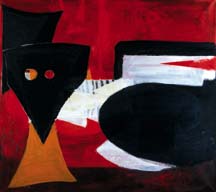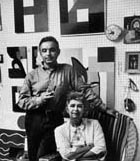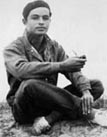
Home | Gallery
Guide | The Provincetown AIDS Art Archives Contact Us | How You Can Help
Contact Us | How You Can Help
A | B | C | D | E | F | G | H | I | J | K | L | M | N | O | P | Q | R | S | T | U | V | W | Y | Z
|
Mischa Richter (1910-2001) |
|
Mischa Richter on the Dunes, Provincetown, 1928. Photographer unknown
|

Creature II, 1982, oil on canvas, 42.5" x 46.5"
Mischa Richter was born in Kharkov, Russia, in 1910. He describes a childhood house that was filled with song and neighborhood streets filled with magicians and acrobats. Richter's work table was beside a window that overlooked the garden, with large sand walks and purple lilacs. Days were spent learning French and German from his Governess, drawing at that table, and playing in Gogol Park: "I don't know when I started drawing. It was long before I started collecting bullets." In 1917 the Revolution erupted around the Richter household. Richter's uncle was killed shortly after joining the Red Army and Richter almost died from a bout with typhoid fever. As the war gained momentum, the festive streets became places of violence. As Commissar of Waterworks of the City of Kharkov, Richter's father was able to erect a temporary economic and academic cushion around his family, providing art tutors, and vacations to Berdyansk. However, being in a position of responsibility the possibility of execution became imminent. The family decided to leave for the United States.
The escape went so smoothly that Mischa Richter hardly remembers being scared. His family left on his father's vacation taking only their clothes, a few suitcases, and a rolled up painting of a seascape in Yalta by Buchumov. They took the train to the Polish border, a cart through the forest and a rowboat into Poland. Their year spent waiting for a visa was one of relaxation and further art training. The passage to the United States was extremely smooth. Cousins met the family at Ellis Island, where they spent no more than an hour. Mischa resumed his art education immediately after arriving in Boston, at the Museum School. The program included daily drawings from the extensive collection of Greek and Roman casts. It was also at the Museum School that Richter met his lifelong friend Will Barnet who was, eight years later, to introduce Richter to Barnet's sister-in-law, Helen Sinclair Annand, also a painter. Richter fell in love immediately and as he is fond of saying, "never left her from then until 1992."
Richter went directly from the Museum School to Yale University, where he studied the earth palette of Eugene Savage. Richter graduated from Yale in 1934 and moved from New Haven back to Boston. In Boston, as part of the WPA, he completed the first narrative mural in Boston at the since-demolished Bouroughs Newsboy Foundation building. The fifty-foot realist mural depicted a newsboy working his way up through the ranks with the professional encouragement of his superiors, which metaphorically connoted worker-friendly management practices. It was written at the time that, Richter's WPA work "shows him to be an artist of depth and power."
Though immediately very successful working for the WPA, Richter quickly turned his professional interests to cartooning. "I never separated cartooning from art in general. I was brought up in an atmosphere of satire and political discussion." Richter's deeply engrained sense of social justice emerges in his artwork. Working intensely with Ad Reinhardt, Richter began drawing for and then became the arts editor of the New Masses, a leading Progressive paper. As liberal intellectuals, Helen and Mischa Richter were closely involved with the Communist movement. However, his enthusiasm for an American Communist Revolution was tempered by his awareness of Stalin's capacity for violence.
"GET ME THE STATUE OF LIBERTY"
Richter's cartooning brought him a substantial salary for the 1940's. He developed the syndicated strip "Strictly Richter" for King Features and did contract work for The New Yorker. He did extensive advertising and had cartoons in Collier's, The Saturday Evening Post, This Week and others. He also published several books, including three for children. His financial security allowed him to paint for his personal enjoyment, without the pressures of making gallery sales. Richter said that though he paints, "I don't show them. If somebody thinks they're good twenty years from now why that will be fine. In the meantime I don't have to stand around and be insulted."1 He has never allowed the art market to infringe upon his enjoyment of medium, line, or creativity.
In the 1950's and 'sixties, Richter made several lengthy trips to Italy and France. In Italy, he spent mornings drawing cartoons for publication and his afternoons walking and painting. Richter did a series of drawings, or "translations" extracting a geometrical expression of the Italian Masterpieces' compositions. He then exhibited these works, along with cartoons, in a 1958 exhibition at the Wadsworth Antheneum in Hartford CT.
Richter's work at this time reflected his involvement in the artistic dialogue that abounded as members of the New York School summered in Provincetown. Richter socialized with many of the familiar names of Abstract Expressionism, including Will Barnet and Robert Motherwell. "During the 'fifties and 'sixties I was influenced by Abstract Expressionism which directed me towards communicating through the formal rather than narrative qualities of my art." Richter first came to Provincetown in 1928 and joined the Beachcombers Art Club in the '50s. He began exhibiting his work at the Art Association in 1950 and has shown here consistently ever since. He bought his first house in Provincetown in 1958. In 1969 Mischa helped found the historical cooperative Provincetown Group Gallery where he showed with many of America's most famous artists.
Richter took a hiatus from public exhibition of his work, which ended in the early 'nineties, after the deaths of his wife and son, Tom Richter. Mischa nursed Helen through her slow debilitation from multiple sclerosis, refusing to have her put in a nursing home. Sasha Richter, Mischa's grandson, described Mischa during Helen's illness as compassionate and devoted. In one of his upstairs windows hangs a painting of Tom Richter as a boy. The image is done with a telling sensitivity and gentleness. He now lives alone and continues to paint and draw every day.
Sitting with Mischa Richter, in his comfortable though cavernous home on the bayside of Provincetown, it is hard to fathom the changes he has witnessed, the struggles he has endured, or the perseverance of his sense of humor and artistic mission. The house is saturated in light reflected off the water. The living room wall is awash in an eclectic array of photographs from Russia, artwork by his wife and friends, and paintings of his children. The upstairs bedrooms are all partially studios with piles of watercolors paintings scattered throughout. The house teems with relics of his life. It is a life of exodus, and of loss, but also tremendous happiness and personal accomplishment.
By Emma Ross
1 Jenkisson, John "Former WPA Muralist Succeeds as
Cartoonist," New York World Telegram, April 30, 1945.
MISCHA RICHTER: A RETROSPECTIVE
July 30 - August 23, 1999
Curator: Jane Winter
Provincetown Art Association and Museum
Catalog available - call PAAM 508 487 1750.
© Provincetown Art Association and Museum
Mischa and Helen Richter. Photograph by Molly Malone Cook

..................................................
© 2001 - 2017 Provincetown Artist Registry | P.O. Box 675, North Truro, MA 02652 | 508 487-0011
